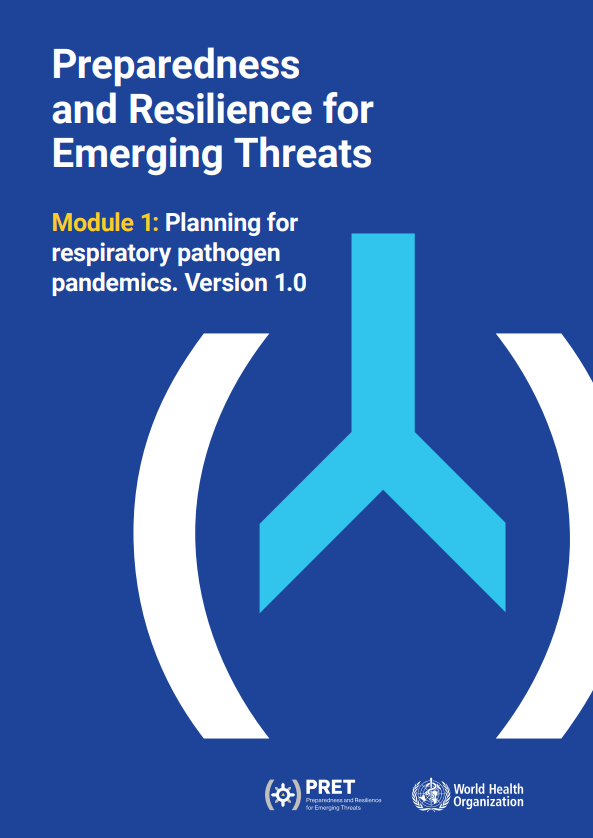/epidemic-and-pandemic-preparedness-and-prevention-(epp)/influenza-preparedness-and-response-(ipr)/pip-story-dprk.jpg?sfvrsn=2f6cd381_3)
Preparedness and Resilience for Emerging Threats (PRET)
PRET initiative in WHO’s South East Asia Region
/epidemic-and-pandemic-preparedness-and-prevention-(epp)/influenza-preparedness-and-response-(ipr)/pip-story-dprk.jpg?sfvrsn=2f6cd381_3)

4 February 2025 | Departmental update
/indiasimex_quote1_pushpa.png?sfvrsn=4cc06f90_2)
21 October 2024 | Departmental update
PRET publications and tools
Overview: Through technical consultations with countries and partners, WHO has led the development of Preparedness and Resilience for Emerging Threats Module 1: Planning for respiratory pathogen pandemics. Version 1.0. The Module, currently available as an advanced draft, builds on previous pandemic lessons and guidance, and has the following new elements:
- It presents an integrated and efficient respiratory pathogen pandemic planning approach covering both novel pathogens and those known to have pandemic potential;
- It enables coherence in addressing pathogen-agnostic and pathogen-specific elements for better preparedness;
- It gives an organizing framework including operational stages and triggers for escalation and de-escalation between pandemic preparedness and response periods;
- It contextualizes 12 IHR (2005) core capacities within the five components of health emergency preparedness, response and resilience (HEPR), from the respiratory threats perspective; and
- It describes the critical sectors for respiratory pathogen pandemic preparedness to trigger multisectoral collaboration.
In line with these objectives, the 2023 Regional PRET Meeting, held alongside the annual PIP Meeting, recommended conducting a simulation exercise in...
Annual Review Meeting of the implementation of Pandemic Influenza Preparedness (PIP) Partnership Contribution (PC) Funding the South-East Asia Region and the simulation exercise on Preparedness and Resilience for Emerging Threats (PRET)
In line with these objectives, the 2023 Regional PRET Meeting, held alongside the annual PIP Meeting, recommended conducting a simulation exercise in 2024. This proposed exercise aims to utilize WHO's global standard simulation tools to support country participants in enhancing their PRET planning efforts and advocating for the review and updating of their national pandemic influenza preparedness plans. Simulation exercises have proven effective in strengthening multisectoral coordination, risk communication, and decision-making processes, thereby improving readiness to manage and mitigate the impacts of respiratory pathogens with pandemic potential.
We are delighted to announce the release on GIP PPP web page of the
Checklist for respiratory pathogen pandemic preparedness planning, inclusive of influenza
This checklist is an operational tool to help national authorities develop or revise national respiratory pathogen (inclusive of influenza and...
This checklist is an operational tool to help national authorities develop or revise national respiratory pathogen (inclusive of influenza and coronaviruses) pandemic preparedness plans. It presents suggested priority actions that countries can take now in order to be better prepared for a pandemic. It is in-line with the Preparedness and resilience for emerging threats (PRET) approach and in conjunction with PRET module 1: planning for respiratory pathogen pandemics. This checklist builds from the 2018 WHO checklist for pandemic influenza risk and impact management: building capacity for pandemic response, the Pandemic influenza risk management (PIRM) guideline and COVID-19 Strategic Preparedness and Response Plan operational checklists, and associated tools, with a focus on the similar capacities that could be leveraged for different respiratory pathogens of pandemic potential to make pandemic planning more efficient and integrated.
To strengthen preparedness, countries are encouraged to leverage what exists and to take two mutually reinforcing approaches: a cross-cutting all-hazards approach and a vertical hazard approach. The scope of the checklist therefore covers all respiratory pathogens of pandemic potential, including specific actions for key respiratory-borne RNA viruses identified as being of heightened pandemic risk, such as influenza, coronaviruses and the threat of novel respiratory pathogen X.

